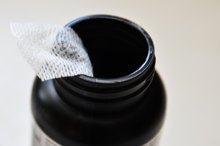How Is a Feeding Tube Removed?
Feeding tube removal is usually performed by a licensed health care professional, either a nurse or physician. Nasogastric feeding tubes are rigid plastic tubes that are inserted through the nose and passed down through the esophagus to rest in the stomach. Duodenal feeding tubes are soft rubber tubes passed with the aid of a guide wire (which is later removed) into the stomach and then beyond it to the duodenum (the part of the small intestine just inches beyond the stomach). Percutaneous endoscopic gastrostomy, or "PEG" tubes, are inserted through the abdominal wall with the aid of an endoscope that has been passed from the mouth into the stomach 2. Nasogastric and duodenal feeding tubes are semipermanent solutions that are left in place for days or weeks, whereas PEG tubes can be left in for years. The process of removal depends on the type of tube.
Nasogastric or Duodenal Tube
Nasogastric and duodenal feeding tubes are generally secured to the nose using tape or some other method. The tape is removed; and with the patient sitting as upright as possible, gentle traction is placed on the tube to begin the withdrawal process from the stomach or the duodenum. Duodenal feeding tubes are typically smaller than hard plastic nasogastric tubes, and extra care is taken during removal as they can stretch and break. As the end of the tube gets near the top of the esophagus, the nurse will likely pause and give the patient a moment to rest. When the patient is ready, the tube is pulled quickly through the oropharynx and out through the nose. This may stimulate the gag reflex, but only very temporarily until the tube is out.
- Nasogastric and duodenal feeding tubes are generally secured to the nose using tape or some other method.
- The tape is removed; and with the patient sitting as upright as possible, gentle traction is placed on the tube to begin the withdrawal process from the stomach or the duodenum.
PEG Tube
What Are the Side Effects of Feeding Tubes?
Learn More
Percutaneous feeding tubes are generally removed by a gastroenterologist or general surgeon. Removal typically involves deflating a balloon on the far end of the tube and withdrawing the tube through the abdominal wall to the outside. Some PEG tubes have a "bumper" that prevents pulling the tube through to the outside, in which case the tube is cut from the inside during an endoscopic procedure and removed through the mouth. In most cases, the external PEG openings are small and heal without formal intervention, but larger openings may need to be closed with sutures.
- Percutaneous feeding tubes are generally removed by a gastroenterologist or general surgeon.
- Some PEG tubes have a "bumper" that prevents pulling the tube through to the outside, in which case the tube is cut from the inside during an endoscopic procedure and removed through the mouth.
Related Articles
References
- “Fundamental and Advanced Nursing Skills;” G.B. Altman, R.N., Ph.D., et al.; 2010
- American College of Gastroenterology: Percutaneous Endoscopic Gastrostomy
- “ACS Surgery: Principles & Practice;” Percutaneous Endoscopic Gastronomy; A. Fanning, M.D., and J.L. Ponsky, M.D., F.A.C.S.; 2009
- Sullivan SN. Functional abdominal bloating with distention. ISRN Gastroenterol. 2012;2012:721820. doi:10.5402/2012/721820
- The Oral Cancer Foundation. Nutrition/feeding systems.
- Philpott H, Garg M, Tomic D, Balasubramanian S, Sweis R. Dysphagia: Thinking outside the box. World J Gastroenterol. 2017;23(38):6942–6951. doi:10.3748/wjg.v23.i38.6942
- Blumenstein I, Shastri YM, Stein J. Gastroenteric tube feeding: techniques, problems and solutions. World J Gastroenterol. 2014;20(26):8505-24. doi:10.3748/wjg.v20.i26.8505
- U.S. National Library of Medicine. MedlinePlus. Jejunostomy feeding tube. Reviewed October 29, 2018.
- American Society for Gastrointestinal Endoscopy. Understanding percutaneous endoscopic gastrostomy (PEG).
- U.S. National Library of Medicine. MedlinePlus. Feeding tube insertion - gastrostomy. Reviewed May 20, 2018.
Resources
Writer Bio
Darrell Spurlock, Jr. Ph.D., is a registered nurse, researcher, and health writer. Spurlock has been writing for more than six years and has published research in several academic journals. He also writes about health for LiveStrong.com. Spurlock has a doctorate in psychology and master's degrees in nursing and psychology.









